Online Certificate
Apply online for a Digi-SSL™ Certificate
![]() Visit https://www.digi-sign.com/product/digi-ssl and select your SSL Certificate product type. You will be required to submit the CSR into a web form. When you make your application, make sure you include the CSR in its entirety into the appropriate section of the enrolment form. When you view your CSR it will appear something like:
Visit https://www.digi-sign.com/product/digi-ssl and select your SSL Certificate product type. You will be required to submit the CSR into a web form. When you make your application, make sure you include the CSR in its entirety into the appropriate section of the enrolment form. When you view your CSR it will appear something like:

Be sure to copy the CSR text in its entirety into the application form, including the:

-
Step one: Copy your certificate to file
You will receive an email from Digi-Sign with the certificate in the email (yourdomainname.cer). When viewed in a text editor, your certificate will look something like:

Copy your Certificate into the directory that you will be using to hold your certificates. In this example we will use /etc/ssl/crt/. Both the public and private key files will already be in this directory. The private key used in the example will be labeled private.key and the public key will be yourdomainname.cer.
It is recommended that you make the directory that contains the private key file only readable by root.
Step two: Install the Intermediate Certificates
You will need to install the chain certificates (intermediates) in order for browsers to trust your certificate. As well as your SSL certificate (yourdomainname.cer) two other certificates, named UTN-USERFirst-Hardware.crt and Digi-SignCADigi-SSLXp.crt or
Digi-SignCADigi-SSLXs.crt, are also attached to the email from Digi-Sign.
Apache users will not require these certificates. Instead you can install the intermediate certificates using a 'bundle' method.
In the Virtual Host settings for your site, in the httpd.conf file, you will need to complete the following:
-
1. Copy this ca-bundle file to the same directory as httpd.conf (this contains all of the CA certificates in the chain).

